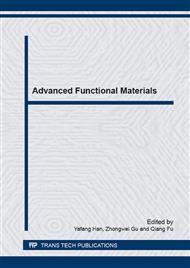p.440
p.446
p.451
p.458
p.464
p.470
p.477
p.483
p.489
Synthesis and Characterization of Optical Active PLA Degradable Materials
Abstract:
An optical active Acrylate end-functionalized poly (lactic acid) (DPLA) was synthesized via melt polycondensation, with lactic acid, polyalcohol and acrylic acid as raw materials. The prepolymer products in each process were characterized by FT-IR, 1H-NMR. The curing PLA coating (CPLA) was prepared using optical active DPLA, reactive diluent and photoinitiator. Gel fraction, thermal stability and degradation properties of the UV curing PLA coating properties were evaluated. The results show that branched structure of hydroxyl-terminated poly (lactic acid) (OHPLA) is beneficial to increase acrylic end capping rate (Da), Da ois as high as 88%. The structure of prepolymer and the performance of the coating are adjusted by changing content of polyalcohol. After crosslinking modification, degradation rate of CPLA is reduced and CPLA has better thermal stability than the pure PLA.
Info:
Periodical:
Pages:
464-469
Citation:
Online since:
March 2015
Authors:
Keywords:
Price:
Сopyright:
© 2015 Trans Tech Publications Ltd. All Rights Reserved
Share:
Citation:


